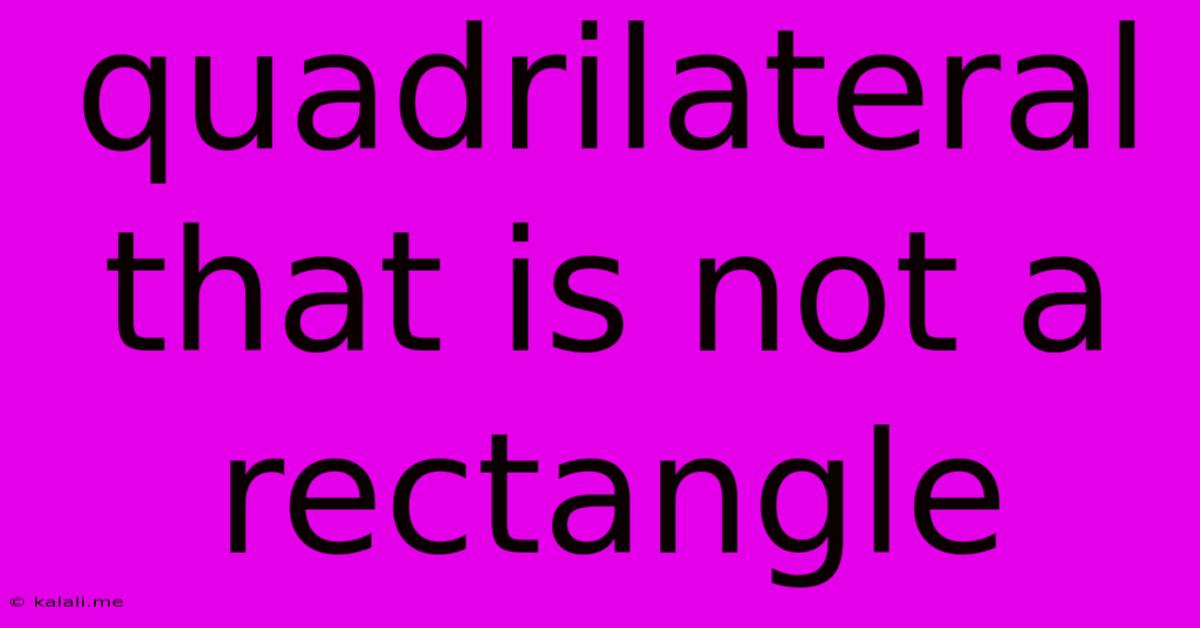Quadrilateral That Is Not A Rectangle
Kalali
May 09, 2025 · 3 min read

Table of Contents
Quadrilaterals That Aren't Rectangles: A Comprehensive Guide
Meta Description: Explore the diverse world of quadrilaterals beyond rectangles! This guide delves into various types, their properties, and how to identify them, covering everything from parallelograms to trapezoids and beyond.
Quadrilaterals are four-sided polygons, a fundamental shape in geometry. While rectangles are a common and well-understood type, the world of quadrilaterals extends far beyond them. This article will explore the fascinating variety of quadrilaterals that aren't rectangles, detailing their unique properties and how they differ from their rectangular cousins.
Understanding the Basics: What Makes a Rectangle a Rectangle?
Before we dive into non-rectangular quadrilaterals, let's quickly review the defining characteristics of a rectangle:
- Four sides: A rectangle, like all quadrilaterals, has four sides.
- Four right angles: Each of the four interior angles measures exactly 90 degrees.
- Opposite sides are parallel and equal in length: This ensures the shape's rectangular form.
Any quadrilateral lacking one or more of these characteristics is, by definition, not a rectangle.
Types of Quadrilaterals That Aren't Rectangles:
Let's explore some prominent examples:
1. Parallelograms:
Parallelograms share some similarities with rectangles but lack the crucial right angle requirement. Their key features are:
- Opposite sides are parallel: This is the defining characteristic.
- Opposite sides are equal in length: A direct consequence of the parallel sides.
- Opposite angles are equal: Another result of the parallel sides.
Examples of parallelograms that aren't rectangles:
- Rhombus: A parallelogram with all four sides equal in length. Think of a tilted square.
- Rhomboid: A parallelogram with unequal adjacent sides. It's essentially a "squashed" rectangle.
2. Trapezoids (Trapeziums):
Trapezoids are quadrilaterals with only one pair of parallel sides. This immediately distinguishes them from rectangles and parallelograms.
Types of Trapezoids:
- Isosceles Trapezoid: The non-parallel sides are equal in length.
- Right Trapezoid: One of the non-parallel sides is perpendicular to both parallel sides.
3. Irregular Quadrilaterals:
These are quadrilaterals that don't fit into any of the more specific categories. They have no parallel sides and no special angle relationships. They are simply four-sided shapes with unequal sides and angles. This is the most general category and encompasses a vast array of shapes.
4. Kites:
Kites possess two pairs of adjacent sides that are equal in length. However, unlike a rhombus, these pairs are not opposite each other. One of the angles is often (but not always) a reflex angle.
Identifying Non-Rectangular Quadrilaterals:
To identify a quadrilateral, carefully examine its properties:
- Measure the angles: Are they all 90 degrees? If not, it's not a rectangle.
- Check for parallel sides: Use a ruler or geometry software to determine parallelism.
- Measure the side lengths: Are opposite sides equal? Are all sides equal?
By systematically analyzing these properties, you can accurately classify any quadrilateral and determine whether or not it's a rectangle.
Conclusion:
The world of quadrilaterals offers a rich tapestry of shapes beyond the familiar rectangle. Understanding the differences between these shapes, their properties, and how to identify them is crucial for mastering basic geometry and further explorations in mathematics. This guide provides a strong foundation for further study of these fascinating polygons.
Latest Posts
Latest Posts
-
Using Polar Coordinates To Find Limits
Jun 01, 2025
-
How Long Does It Take To Restore An Iphone
Jun 01, 2025
-
Build Covered Parking Spot Attached To Garage
Jun 01, 2025
-
How To Open A Glass Bottle Without A Bottle Opener
Jun 01, 2025
-
What Kind Of Rice Goes With Butter Chicken
Jun 01, 2025
Related Post
Thank you for visiting our website which covers about Quadrilateral That Is Not A Rectangle . We hope the information provided has been useful to you. Feel free to contact us if you have any questions or need further assistance. See you next time and don't miss to bookmark.